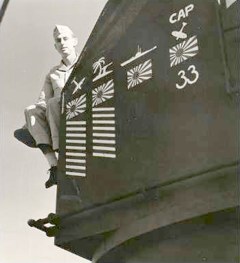
Insignias on gun director reflect 9 aircraft shot down, 8 shore bombardments, 1 [sic] submarine sunk, 33 planes destroyed by combat air patrol (CAP).
After a brief shakedown period in the Atlantic, HUDSON was ordered to Éfaté, New Guinea, where she reported to Commander-in-Chief, U.S. Pacific Fleet, for duty. She was just in time to take part in the initial landings on Bougainville Island in the Solomons. Here she provided shore fire support as well as an anti-aircraft umbrella for those on the beach. Two Jap marauders were accounted for by her guns and she was given credit for an assist in the destruction of a third in a heavy air assault on 8 November. She was out on anti shipping sweeps in the Truk area in succeeding months and then engaged in the landings on the green Islands and Emirau.
After a welcome breather in Sydney, Australia, the tough little destroyer steamed north to join the great armada being assembled for the Marianas campaign in the summer of 1944. Assigned to a transport group screen, HUDSON participated in the landing on Saipan and Tinian; dashed down to Guam for a bombardment there; joined Task Force 58 for the first Battle of the Phillipines Sea where she shot down two enemy planes; escorted a covering force off Saipan where she shot down another plane; covered the underwater demolition teams at Guam and brought her guns to bear on key targets along the coast of that island in the softening up period prior to invasion. During this period, HUDSON effected the rescue of 3 Navy Fliers who had had their planes shot out from under them and one Nip pilot found floundering in the sea.
The Navy's drive westward across the Pacific was in full swing in 1944 and HUDSON moved swiftly south from the Marianas Group to join the THIRD FLEET's operations at Palau in September. The initial assignment was bombardment, preparatory to the landing on Angaur. To the subsequent invasion, HUDSON delivered call fire on both Angaur and Pelelieu. On 28 September the ship proceeded to Manus in the Admiralties for logistics and thence to San Francisco California, for overhaul. Round one was over and HUDSON had just begun to fight
The overhaul was completed on 7 December 1944 and HUDSON proceeded to Pearl Harbor for refresher training and further assignment. In February of 1945 HUDSON sailed in company with a transport group, every ship of which was jammed with Marines and all the material necessary for a successful major operation. The destination was the island of Iwo, where one of the bloodiest battles of the war was subsequently fought. The Japs realized only too well that their innermost defenses had been breached and were not willing to let the matter go uncontested. DD475 blasted Jap gun emplacements and thick concrete pillboxes; served on patrol around the transports off the quaking beach; operated as radar picket ship; on several occasions assumed visual fighter director control of the Combat Air Patrol. A total of 1,453 rounds of ammunition were expended by her five-inch guns within the shadow of Mount Surabachi.
This ship departed the area on 6 March 1945, returning to Saipan in company with a task unit. Two days later, she located and brought safely from the water six members of a B-29 crew forced down in perilous waters off that island. On 10 March, HUDSON retired to Ulithi for logistics. Round two was over and HUDSON was fighting.
Okinawa was the next test for ship and crew and she met well. HUDSON joined a task unit at Leyte and left for big show on 27 March 1945. The curtain went up on April Fool's Day but this was no seasonal prank. This was an all-out effort to crush the Nipponese right on their own doorstep, the final stone in achain of stepping stones which has begun with Guadalcanal.
HUDSON assumed duties as a radar picket ship and on 5 April while on her station, she made contact with an enemy submarine. Destroyer tracked submarine for six hours, at no time losing contact for more than a few minutes. A total of six depth charge attacks were made which resulted in the destruction of the submarine, for which HUDSON was given full credit.
A Kamikaze plane slightly damaged HUDSON on 22 April. Unsuccessful in its attempt to hit the bridge, largely because of the heavy volume of machine-gun fire which riddled it. The plane crossed the forecastle, carried away the jackstaff, and splashed close aboard to port. As a radar picket ship, HUDSON was very successful in utilizing its Combat Air Patrol, destroying 33 aircraft and accounting for three more with her guns.
On 4 May she came alongside USS SANGAMON (CVE 26), to help her fight a raging fire caused by an enemy aircraft which had crashed into her. The assignment proved to be anything but comfortable. The overhanging flight deck of the heavily rolling CVE gouged into the super-structure of HUDSON, tore away the port wing of the bridge, knocked a big searchlight off its mounting, and smashed 40mm gun mount. Desperately clearing their flight deck, crewmen of the escort carrier jettisoned a flaming airplane, only to have it land neatly on the fantail of HUDSON, starting fires there. A flaming flag bag from the carrier also was pitched on the weather deck of the destroyer. The fire was eventually brought under control but HUDSON had suffered more as a result of the fire than had the original victim. She then proceeded to Guam for repairs. Round three was over and HUDSON had fought
For the splendid record she made in the Okinawa area, USS HUDSON has since been awarded the Navy Unit Commondation.
Source: USS Hudson home page.